A month ago, one of the runners I coach contacted me in a panic. We’ll call him “Adam.” He’s training for a sub-three-hour marathon and is, consequently, pouring himself into his training.
So far, everything in his preparation has been going to plan. He’s healthy. His workout times are solid. He’s hitting overall mileage levels that are challenging but manageable. Adam has also been feeling good for most of his training, so he’s right where I’d like him to be.
But Adam was panicking over his cadence. Last week, he ran two of his easy runs with an average cadence of 169 steps per minute. Usually, his cadence lands at around 170 to 171 steps per minute.
Was Adam right to panic over his cadence slipping ever so slightly? Was this a sign of excessive fatigue? Would this trend keep progressing over time?
Having this immediate, ongoing access to so many metrics about your running is both a blessing and a curse. In this case, Adam had nothing to worry about, but let’s discover why.
Drawbacks to Data
Now that runners have such unprecedented access to robust training and bodily data, it can be tempting to pore over every detail to determine what can be optimized to ensure great performances, fewer injuries, and longevity in the sport. But therein lies the risk. Humans are not robots, and our data is often messy, which can cause us to interpret temporary changes as permanent.
Adam’s cadence, for example, might have been affected by his sleep, overall fatigue, shoe choice, the terrain he was running on, or a number of other variables. Let’s also consider that, at such a low variability from his “normal” cadence, there could have also simply been a measurement error. GPS cadence accuracy isn’t 100 percent accurate, anyway.
Alas, his cadence improved the following week, and we stopped paying attention to this metric. But that didn’t stop him from anxiously stressing out over it, likely spiking his cortisol levels unnecessarily and compromising recovery.
RELATED: The Best Sports Watches 2023
In this case, access to data led to perfectionism, which has no place in running. Because we’re not robots, our progress is rarely linear. We experience setbacks, plateaus, and minor blips in our training as our ability to recover varies over time and life stressors come and go.
If we attempted to increase our mileage with unwavering linearity, run perfect workout splits, have the correct cadence at every moment during a run, or negative split every long run, we would usually fail.
Measuring the performance of our bodies serves as a constant reminder that our biological systems do not behave as neatly as we’d like them to.
Data Makes us Perform (for Others)
The other major problem with the data our smartwatches provide is that they often cause us to train performatively. Instead of training appropriately and strategically, many will train in a way that will look impressive on platforms like Strava.
This happened to me just yesterday. Instead of running an easy five miles, I relied more on pace so that I would have a nice round number to show off on Strava. While my body wanted to run five miles at an easy effort, in about 38:45, I sped up over the last two miles so that the clock was an even 38:00 when I finished.
Almost any runner with a smartwatch has dabbled in this data overload, pouring over charts and graphs to find the signal in the Eras Tour-level noise. But ultimately, that result is meaningless in the grand scheme of things.
Besides the physical disadvantage of running easy runs too fast, there’s also a psychological component to this problem: it makes us feel like we’re not training well. Our runs feel inadequate, especially when we fall into the comparison trap on social platforms.
Do Smartwatches Impede Long-Term Development?
There’s also another major problem with relying too heavily on your smartwatch: it may hamper your long-term development of interpreting your body’s communication signals.
This plays out in two different scenarios. The first and most common is pacing ability. GPS watches are now more accurate than ever at displaying your current running pace. That helps us fine-tune our effort during workouts, races, and long efforts. The problem is that we now must rely on a watch to fine-tune our paces. It’s becoming more and more difficult to intuitively understand how fast you’re running and how to adjust your pace in real-time.
RELATED: One Runner Followed His Watch’s AI Training Plans for a Month. Here’s What Happened.
Certain GPS watches also provide runners with fitness and recovery scores, alongside specific suggestions on what workouts to run and how much recovery to take. This sounds great in theory, but over time it can erode a runner’s subjective judgment on their fatigue level and injury risk. Instead of listening to their body, they listen to their watch—informed by proprietary algorithms—and, therefore, are less able to learn what their body is trying to tell them.
This may keep you healthier in the short-term, but at the expense of better knowing your body over the long-term.
Three Smart Tips for Smartwatches
Despite this encroaching overreliance on our GPS gadget’s feedback, smartwatches can, of course, be incredible training tools. We now have the power to peer into the minute details of our physiology and performance to better guide our training. While misinterpreting or overanalyzing metrics is common, we can use these tools more effectively if we better understand them and our bodies.
- Focus more on objective metrics than subjective metrics. The distance, pace, and overall time of your run is more important than an algorithmic “score” that tells you how many hours are needed until you’re ready for your next training session. It’s much more difficult to get those objective metrics wrong (and watch technology means these values are more accurate than ever).
- Focus on trends over time rather than specific moments in time. Training is rarely linear, so don’t be upset if your cadence decreases temporarily, your heart rate variability is low one day, or your pace isn’t “normal” on a random Tuesday. Like Adam’s cadence discussed earlier, some “problems” are not actually problems at all; they’re simply reflections of the fact that you are a biological system, and variability is always going to exist.
- Remember that subjective markers are estimates. Things like recovery scores, training readiness, or estimated finish times are simply guides and best guesses, rather than firm realities. Your watch does not know you better than you know you.


